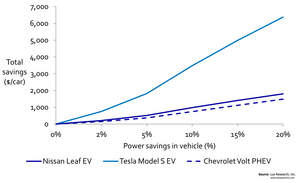BOSTON, MA--(Marketwired - Aug 12, 2014) - Wide bandgap (WBG) materials such as silicon carbide (SiC) and gallium nitride (GaN) are best positioned to address emerging power electronics performance needs in electric vehicles (EVs), with SiC displacing silicon as early as 2020, according to Lux Research.
As silicon struggles to meet higher performance standards, WBG materials are benefiting critically from evolving battery economics. On Tesla Model S, for example, a 20% power savings can result in gains of over $6,000 in battery cost, or 8% of the vehicle's cost.
"Efficient power electronics is key to a smaller battery size, which in turn has a positive cascading impact on wiring, thermal management, packaging, and weight of electric vehicles," said Pallavi Madakasira, Lux Research Analyst and the lead author of the report titled, "Silicon vs. WBG: Demystifying Prospects of GaN and SiC in the Electrified Vehicle Market."
"In addition to power electronic modules, opportunities from a growing number of consumer applications -- such as infotainment and screens -- will double the number of power electronic components built into a vehicle," she added.
Lux Research analysts evaluated system-level benefits WBG materials are bringing to the automotive industry, and predicted a timeline for commercial roll-outs of WBG-based power electronics. Among their findings:
- Power saving threshold lower for EVs. At 2% power savings, if battery costs fall below $250/kWh, SiC diodes will be the only economic solution in EVs requiring a large battery, such as the Tesla Model S. However, for plug-in electric vehicles (PHEVs), the threshold power savings needs to be a higher 5%.
- SiC ahead in road to commercialization. SiC diodes lead GaN in technology readiness and will attain commercialization sooner, based on the current Technology Readiness Level (TRL). Based on the TRL road map, SiC diodes will be adopted in vehicles by 2020.
- Government funding is driving WBG adoption. The U.S., Japan and the United Kingdom, among others, are funding research and development in power electronics. The U.S. Department of Energy's Advanced Power Electronics and Electric Motors is spending $69 million this year and defining performance and cost targets; the Japanese government funds a joint industry and university R&D program that includes Toyota, Honda and Nissan.
The report, titled "Silicon vs. WBG: Demystifying Prospects of GaN and SiC in the Electrified Vehicle Market," is part of the Lux Research Energy Electronics Intelligence service.
About Lux Research
Lux Research provides strategic advice and ongoing intelligence for emerging technologies. Leaders in business, finance and government rely on us to help them make informed strategic decisions. Through our unique research approach focused on primary research and our extensive global network, we deliver insight, connections and competitive advantage to our clients. Visit www.luxresearchinc.com for more information.
Contact Information:
Contact:
Carole Jacques
Lux Research, Inc.
617-502-5314
carole.jacques@luxresearchinc.com
